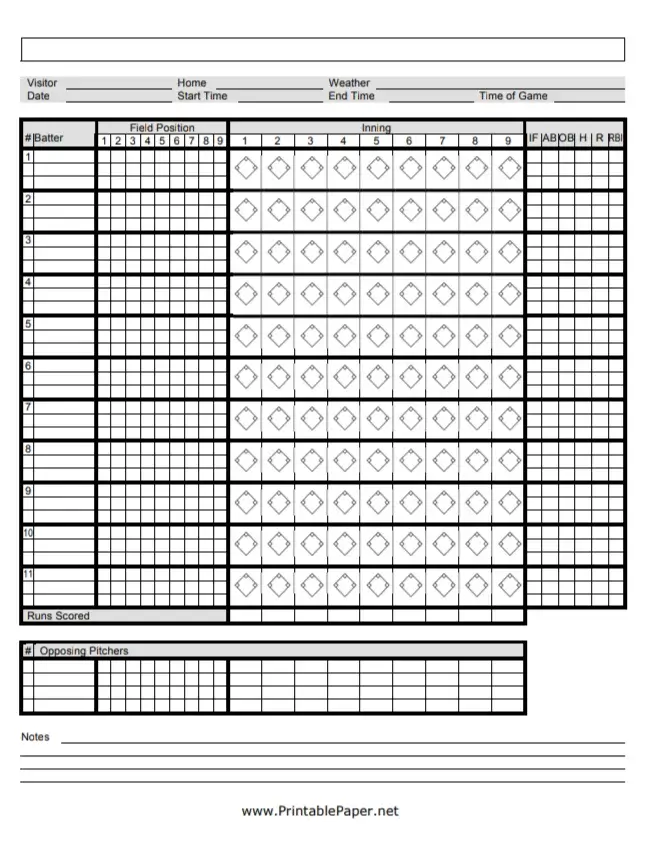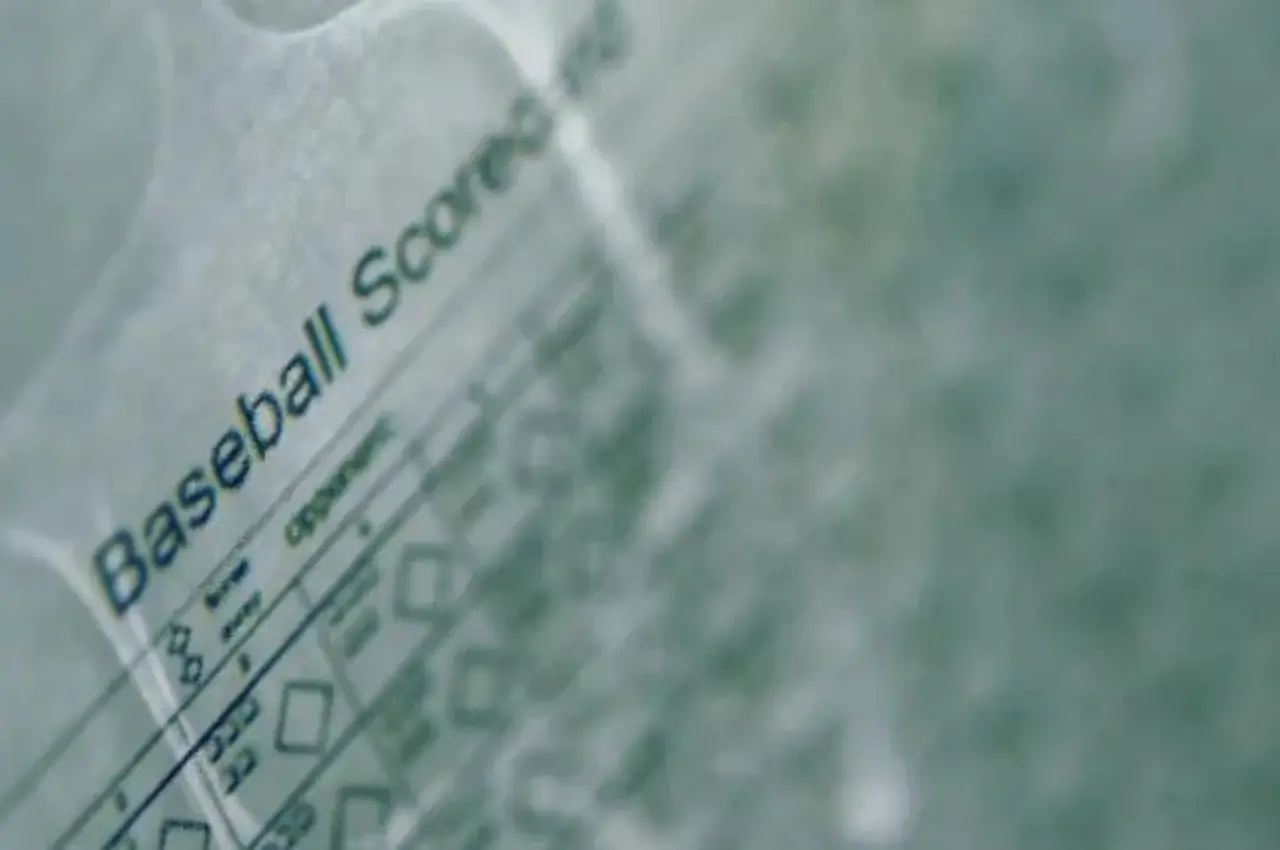The first baseball match I ever scored was the first official night game at Wrigley Field, on August 9th, 1988. I had a game program that I’d obtained when I visited Citi Field (then Shea Stadium) for the first time in 1987–an exciting Mets-Pirates doubleheader–and in the middle was a scorecard. It’s a shame that I no longer have that program. As many of you fans will recall, the game was supposed to take place against the Phillies; game started but was called after four innings due to rain. The next day, NBC broadcast the Mets against the Cubs, and I can still remember the game quite vividly.
In this post, I intend to share with you my knowledge of how to keep score in baseball, and this will add a whole new level of appreciation for you for the game. Not only will you be able to look back at each game whatever you’d like, but for many, including myself, keeping score in baseball is a unique art form that should be considered by any aficionado of baseball.
Then, if you’d like, after reading his article, you can download our free baseball scoring cheat sheet, to help you learn the basics and get started on this this fun activity. Scoring a baseball game is a great skill to have.
Scoring a baseball game is a valuable skill, and by the end of this post, you’ll have the knowledge to confidently keep score and engage with the game on a deeper level. Let’s dive in and make the game even more rewarding.
This post contains affiliate links. Please read our disclosure.

What Is Keeping Score in Baseball?
Keeping score in baseball refers to the practice of recording and tracking the events of a baseball game in a scorecard. A scorecard is a pre-printed or custom sheet where one can note the players, defensive plays, base-running, and scoring actions for both teams. This includes information such as hits, walks, strikeouts, runs, and defensive plays like putouts and assists. By keeping score, fans and analysts can follow the flow of the game, analyze player performance, and have a comprehensive record of the match’s key moments. It’s a traditional way for fans to actively engage with the game and gain a deeper understanding of the strategies and dynamics at play on the baseball field.
It’s important to note that in 2023, baseball changed some of its rules, and in the process the way you keep score has changed. Here is a rundown of some of the changes:
Is There an Official Standard for Keeping Score in Baseball?
While there isn’t a single official standard for keeping score in baseball, there are widely accepted conventions and symbols used on scorecards that provide a consistent method for recording game events. Various organizations, including Major League Baseball (MLB), have scorekeeping guidelines, and many fans and statisticians follow these conventions. Common symbols include numbers to represent player positions, abbreviations for plays (e.g., K for strikeout, BB for walk), and symbols for different types of hits. The official MLB rulebook also includes guidelines for official scorers at professional games. Individual scorekeepers may have some variations in their personal shorthand, but the overall principles remain consistent.
What’s more, in 2023, Major League Baseball made some sweeping changes to some of the rules, necessitating a change in keeping score in baseball. As it stands, you’re free to use whatever symbols or notes you’d like for these new rules. What’s important is that you under stand what they mean and can also reread the scorecard later on and follow the game, as can others. For 2024, there were even more rules changed.
Here are some common symbols used in baseball scorekeeping along with their meanings:
- Numbers (1-9): Represent player positions on the field.
- K: Indicates a strikeout.
- ꓘ: Means strikeout looking.
- BB: Represents a base on balls, commonly known as a walk.
- H: Stands for a hit.
- HR: Denotes a home run.
- R: Represents a run scored.
- E: Indicates an error committed by a fielder.
- 1B, 2B, 3B: Represents a single, double, and triple, respectively.
- SB: Stands for stolen base.
- CS: Denotes a caught stealing.
- DP: Represents a double play.
- WP: Indicates a wild pitch.
- PB: Stands for a passed ball.
- GIDP: Denotes a ground into double play.
These symbols are commonly used on a baseball scorecard to efficiently record and communicate the key events of a game.
What Does a Baseball Scorecard Look Like?
A baseball scorecard is a structured grid used to record and track the details of a baseball game. It typically includes columns for player positions, at-bats, hits, runs, and defensive plays. Each player’s name and position are listed, and specific symbols and abbreviations are used to denote various game events, such as strikeouts, walks, hits, and more. A well-organized scorecard provides a visual representation of the game’s progression, allowing fans to analyze and relive key moments. Here’s a simplified example:

Keeping Score in Baseball
1. Setting Up the Scorecard
Before the game begins, prepare a scorecard by drawing a grid with two columns–one for the home team and another for the visiting team. Each column represents the progress of the respective team. List the player names in their designated positions in the lineup.
2. Scoring a Base Hit
When a batter hits the ball and successfully reaches first base, denote it as a single (“1B”) next to the batter’s name. If the hit advances the batter to second, mark a double (“2B”). Similarly, mark triples (“3B”) and home runs (“HR”) for hits that reach third and home base, respectively.
3. Recording Outs
Use numbers 1-9 to represent the defensive positions on the field. When a defensive player makes a play resulting in an out, circle the corresponding number. For example, if the shortstop (position 6) catches a fly ball, circle the number 6.
4. Notating Strikes and Balls
Keep track of a batter’s performance by using vertical lines to represent strikes (up to three per at-bat) and diagonal lines for each ball (up to four for a walk). This helps in understanding the count and predicting the batter’s next move.
5. Recording Runs
When a player successfully crosses home plate, mark an “R” and connect it to the player’s name in the lineup. This illustrates which players contributed to the team’s overall score.
6. Tracking RBIs
If a batter hits the ball and a run scores as a result, mark an “RBI” next to the batter’s name. Connect this notation to the player who successfully crossed home plate. This provides insight into each player’s offensive contribution.
7. Recording Stolen Bases in Baseball Scorekeeping
To indicate a stolen base in baseball scorekeeping, mark “SB” along the base path between the two bases on your scorecard (e.g., from first to second if the player steals second base). If the player is caught stealing, use “CS” to signify “Caught Stealing.”
8. Noting Pick-Offs in Baseball Scorekeeping
For a pick-off in baseball scorekeeping, you can mark “PO” and the base number where the player was picked off (e.g., “PO1” for a pick-off at first base).
9. Handling Substitutions
If a pinch hitter or substitute enters the game, note the change on the scorecard by adjusting the lineup accordingly. This ensures an accurate representation of the game’s dynamics.
8. Pitcher Changes
Keep track of changes in pitchers, noting the inning in which they enter the game. This information is vital for understanding the performance of each pitcher and how it contributes to the overall strategy.
10. Double & Triple Plays
In the event of a double play, denote it with “DP” and connect it to the players involved. Similarly, TP would indicate triple play.
11. Errors
If a defensive player makes an error, mark an “E” followed by the defensive player’s number. Connect this notation to the at-bat, emphasizing moments that affected the game’s outcome.
12. Inning Changes
At the end of each half-inning, summarize the runs and hits for that inning. This provides a snapshot of the game’s progression and momentum shifts.
13. Game Summary
Toward the bottom of the scorecard, compile a comprehensive summary including the total runs, hits, errors, and the winning pitcher. This serves as a quick reference for the overall outcome of the game.
| Player | 1 | 2 | 3 | 4 | 5 | 6 | 7 | 8 | 9 | Runs |
|---|---|---|---|---|---|---|---|---|---|---|
| Home Team | 1 | 0 | 2 | 0 | 0 | 3 | 0 | 0 | X | 6 |
| Away Team | 0 | 2 | 0 | 1 | 0 | 0 | 0 | 0 | 1 | 4 |
Conclusion
In sharing the intricacies of baseball scoring, I hope to open a new dimension of appreciation for the game. Beyond the nostalgia of reviewing past games, keeping score in baseball is a unique art form, enriching the experience for aficionados and fans alike.
If you’re inspired after reading this article, consider downloading our free baseball scoring cheat sheet. It’s a helpful resource to grasp the basics and embark on this enjoyable activity.



